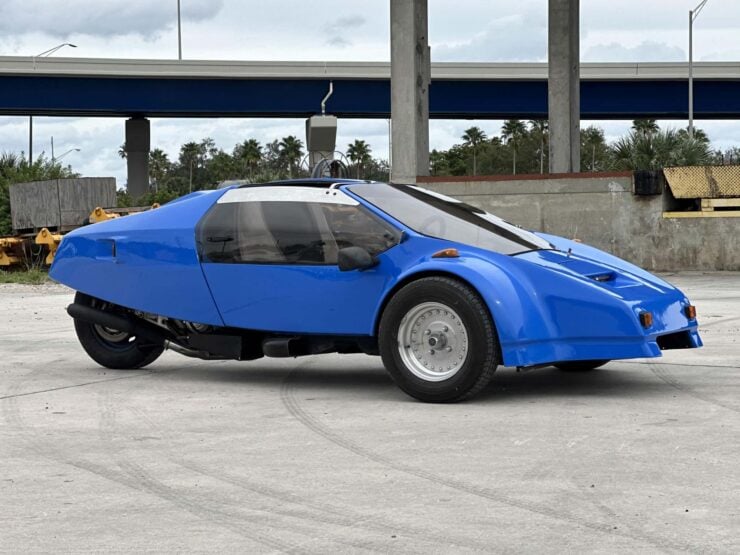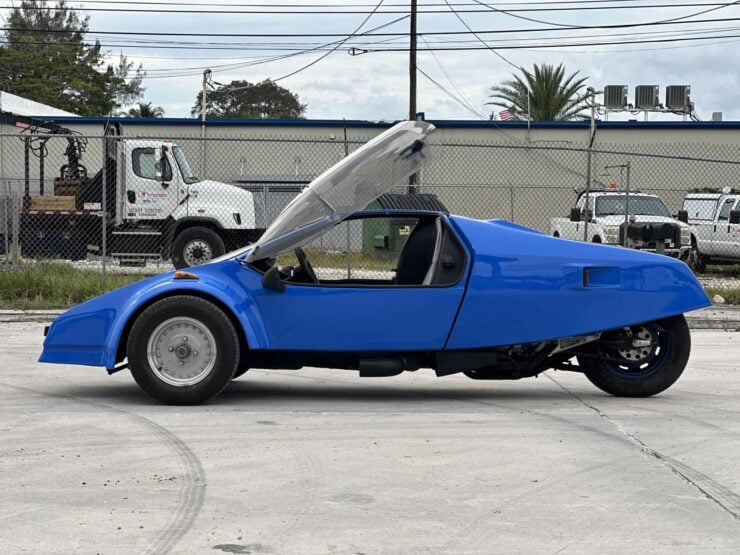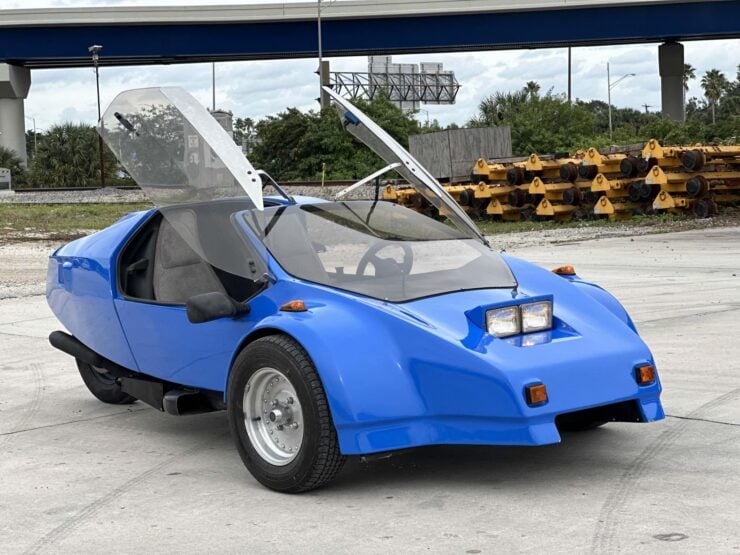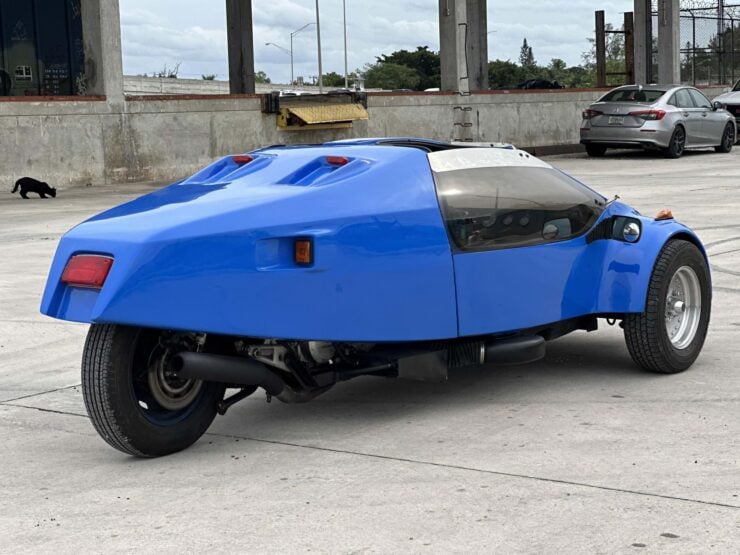This is the Industrial Design Research FireAero, it’s an exceedingly rare vehicle with just 30 believed to have been built by the Laguna Beach-based company in the 1980s.
Industrial Design Research (IDR) was founded by David Stollery, a former child star and later a graduate of California’s Art Center College of Design. Stollery had an illustrious career, he’s best-known today as the designer of the iconic lifeguard towers used in California.
Fast Facts – The Industrial Design Research FireAero
- David Stollery is a former child actor best-known for his role in Disney’s “The Adventures of Spin and Marty.” As a young adult he made a significant career change – pursuing automotive design after enrolling at the Art Center College of Design in Pasadena, California.
- Stollery later worked for General Motors in the 1960s. He was also a key figure in establishing CALTY, Toyota’s California design studio, where he designed the second generation A40 Series Toyota Celica in 1978. In all, he’s said to have directed the design of more than 22 models for Toyota.
- Stollery’s involvement in automotive design led him to work on the TriHawk, a groundbreaking three-wheeled sports car, for millionaire Lou Richards. After Richards’ death, Stollery founded his own company, Industrial Design Research, leading to the development of the FireAero.
- The vehicle you see in this article is an original Industrial Design Research FireAero, one of the fewer than 30 examples that were made. It’s powered by a 1981 Honda CB750F engine, it has seating for two, butterfly doors, and removable roof panels.
David Stollery: From Child Star To Car Designer
David Stollery was one of the biggest child stars of his time, he started out acting on Broadway at the age of just 7, and was promptly voted Child Actor of the Year for his work in the Broadway production of On Borrowed Time starring Victor Moore.
 These are some original schematics of the Industrial Design Research FireAero, it gives a great look into just how much of the original donor motorcycle is used when building it. Image courtesy of Industrial Design Research.
These are some original schematics of the Industrial Design Research FireAero, it gives a great look into just how much of the original donor motorcycle is used when building it. Image courtesy of Industrial Design Research.After switching to film and television, Stollery would appear in almost two dozen movies and episodes including I Love Lucy, Dragnet, Westward Ho, the Wagons!, Drango, Ten Who Dared, and perhaps most famously, in The Adventures of Spin & Marty series on Disney.
As he entered his late teens, Stollery began to question whether he wanted to continue on in acting or pursue another career. Ultimately he was accepted into the prestigious Art Center College of Design in California, and it would be the beginning of a whole new chapter in his life:
“I started working when I was six years old, became well-known, and was making good money. I asked myself if this was what I wanted to do with my life and the answer was ‘no.’ I’d always been interested in drawing and design so when I was accepted into the Art Center College of Design, now in Pasadena, I knew I’d made the right decision.” – David Stollery, via Rare Component Cars
After graduating from the Art Center College of Design, Stollery went to work for General Motors as an automobile designer, he remained there for seven years before being offered a lucrative new position with Toyota. He would become one of the founding members of Toyota’s then-new Calty Design Research center in California.
 The interior is minimalist, with just two seats, three pedals, a steering wheel, and a shifter linked to the motorcycle’s sequential transmission.
The interior is minimalist, with just two seats, three pedals, a steering wheel, and a shifter linked to the motorcycle’s sequential transmission.Working for Toyota he would design the second generation A40 Series Toyota Celica in 1978. In all, he’s said to have directed the design of more than 22 models for Toyota during his time with the company.
The Switch To Three-Wheelers
After a number of years working for Toyota, he was hired by millionaire Lou Richards to design the front-wheel-drive “Trihawk” three-wheeled sports car.
Though unusual the Trihawk showed a lot of promise, after Richards’ death Stollery founded his own company in California, Industrial Design Research (or IDR), to develop a new three-wheeler.
This new vehicle would be powered by a single rear wheel and have two wheels up front. It was called the FireAero, and it was entirely unique in its design.
The Industrial Design Research FireAero
The Industrial Design Research FireAero was an entirely new concept as it utilized almost an entire motorcycle in its design. A new two-seat cabin was developed that bolted directly to the motorcycle frame’s front down tubes, this front cabin had two front wheels with steering, suspension, and brakes, but all of the propulsion duties were handled by the motorcycle rear end.
 Here you can see the 1981 Honda CB750F motorcycle in the rear of the vehicle that provides its motive power.
Here you can see the 1981 Honda CB750F motorcycle in the rear of the vehicle that provides its motive power.The motorcycle would remain in largely unchanged condition after the forks and front wheel were removed and the rear tire was replaced with something offering a flat tread cross section rather than the curved cross section of a motorcycle tire – this was for better traction as the motorcycle now didn’t have the weight of the rider on the seat, but rather the weight was further forward.
The front end section of the FireAero included a steel subframe, a fiberglass body with butterfly doors, removable roof panels, and seating for two. The front suspension is said to have been sourced from a Volkswagen, and the steering assembly came from a Chevrolet Chevette.
Industrial Design Research recommended that a Honda CB750 was used as a donor car, it was recommended that a 750cc motorcycle or larger was used to ensure there was ample power for the car. Period reviews commented on the fun driving experience and the fact that people waved at you wherever you drive, but also noted that the assembly process was not for the first time car builder.
As a three wheeler, the FireAero is officially classed as a motorcycle, making registration far easier. In all, it’s believed that only approximately 30 FireAero kits were sold to customers, and it’s not known how many of these were assembled into functional vehicles, or how many have survived to the current day.
Interestingly, one example of the FireAero appeared in a 1990s TV series based on DC’s The Flash, probably the vehicle’s single biggest claim to fame.
The 1981 IDR FireAero Shown Here
The vehicle you see here is an original FireAero, based on a 1981 Honda CB750F motorcycle and an Industrial Design Research kit from the 1980s.
 In 1986 Camron E. Bussard of CycleWorld Magazine did a review of the FireAero, noting how popular it was with onlookers and how direct the sensation of driving it was.
In 1986 Camron E. Bussard of CycleWorld Magazine did a review of the FireAero, noting how popular it was with onlookers and how direct the sensation of driving it was.It has a blue fiberglass body, tinted side windows, removable roof panels, and it’s powered by an air-cooled 749cc DOHC Honda inline-four with a sequential 5-speed manual transmission.
It has just 8,000 miles on the odometer and it’s now being offered for sale at no reserve out of Florida with a clean Indiana title identifying the vehicle as a 1981 Honda motorcycle on Bring a Trailer. If you’d like to read more about it or register to bid you can visit the listing here.























Images courtesy of Bring a Trailer








